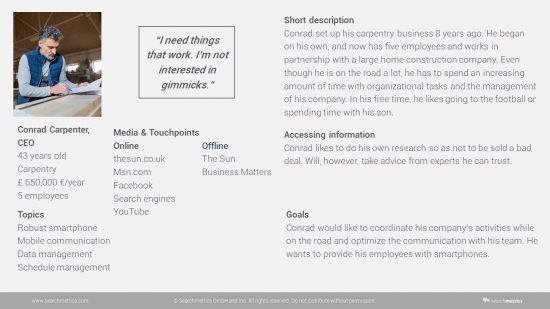Advertising is everywhere – on average, we see between 4,000 and 10,000 advertising messages every day. With communication taking place to such an excess, it is inevitable that the vast majority of messages will be irrelevant and miss their target. In this blog post, we explain how you can use persona groups for your business to help create more relevant messages that appeal to the needs and interests of your (potential) customers.
Wherever we go, wherever we look, we are bombarded by advertising – at bus stops, on the way to work or via banner ads on the internet. The number of advertising messages we see varies between 4,000 and 10,000 every day. The majority of these messages are irrelevant, meaning quite simply that companies are producing content that is of no interest to their target audience. Businesses aren’t making the most of their potential because they are failing to address the needs and interests of their target audience, and are too often investing in empty, meaningless slogans.
Video: Creating personas for more relevant content
If you’re into audio-visual content, here’s the recording of our recent webinar, where Marlene Borst, Key Account Manager Content at the Searchmetrics Digital Strategies Group, and I show you can create personas to improve the effectiveness of your product communication. You can watch the video here:
The aim: Less noise, more impact.
Instead of addressing the general public with classic product communication measures, companies should first listen, and identify the needs and interests of their target audiences. They can then consider this information when developing their communication and their activities. But how do you stand out from the crowd? How can you precisely identify the relevant characteristics and the relevant topics that really matter to your target audience?
A persona is a fictional character who represents a specific segment of your target audience. A persona includes identifying characteristics like interests, challenges, wishes, goals, media consumption behavior and habits of accessing information. A segment has to be large enough to enable specific communication and methods of address. And it has to differentiated from other segments within the target group. The product being marketed can be the same for different personas, but the approach will differ based on their individual needs and behavior. Relevant topics, messages, forms of address and appropriate imagery can vary greatly from one persona to the next.
Example: A typical target group for a streaming provider could consist of the following: 14-35 age bracket, male and female, resident in the US. A persona approach, on the other hand, would emphasize the interests and needs of a target group segment – e.g. horror fans, comedy fans or series addicts.
What’s the difference between target groups and personas?
A target group exclusively looks at demographic characteristics like age, sex, level of education, disposable income or location. This approach clusters consumers into large groups with similar characteristics. However, it lacks any detailed analysis of individual topics and challenges.
With the help of personas, you can get more detailed insights into the needs of different relevant user prototypes. This gives you a clearer picture of the needs of your audience and creates added value for both the business and the targeted groups of people. The benefits of this approach have helped personas become established as a useful marketing tool – even beyond content marketing – as a way of generating ideas.
Create a persona in five easy steps
- Define the relevant components that make up your persona: Which information is relevant for you as a business? What do you need to know about your personas?
- Gather information and ask lots of questions: Where can you look for information? Which data sources can you use?
- Structure und and sort the data you have gathered: Which information don’t you need? Which information is helpful? Which information can be summarized/grouped together? Can you spot any patterns or clusters?
- Create the personas: How can you put the information together to create living, useful personas?
- Use your personas: How can I use the personas to guide my content creation and in other areas of my day-to-day work?
Each step is described in more detail in the following.
1. Defining the relevant components
The first step is to roughly define clusters based on specific characteristics. The initial clusters depend on the target groups and the product or business. For a B2B software company, this could be the position in the market. For cosmetics companies, the physical characteristics of the target personas could be more important. The outline for the first clusters could use:
- Demographic data
- Interests and hobbies
- Physical characteristics
These clusters can be supplemented with further relevant information:
- Communication behavior (phone, email, messenger services etc.), how they access information (how and where? with own research, by asking experts, friends, family etc.?)
- Concrete touchpoints and media consumption (TV, Google, social media, print media, email etc.)
- Purchasing habits (where do they buy things? Online, Offline, Smartphone? Boutique shops, established brands?)
- Challenges and needs
- Personal characteristics (are they an impulse buyer or do they do lots of research?)
- Goals (what are they looking to achieve, in the short, medium and long term?)
- Daily routine (office environment and relevant contacts in a B2B context)
- Attitude towards and awareness of products and brands
2. Gathering data and information
There are many different sources available when gathering data and information for the creation of personas:
Interviews and surveys:
- Existing customers
- Potential target groups
- Internal stakeholders (sales team, customer service)
- Online or offline surveys
Social listening
- Comments on company pages
- Linked comments
- Analysis and tracking of certain topics
- Analysis of relevant blogs and forums
- Product reviews
Desk research
- Statistical analysis
- Sigma/Sinus Milieus
Data analysis
- Analysis of CRM data
- Google Analytics
- Searches on your own website
- Keyword analysis
- Google Suggest for relevant topics
- Google Search Console
4. Structuring data and information
The main aim of this phase is to identify patterns and complement these with appropriate information:
- Which information is not useful/irrelevant and what can be ignored?
- Which information fits with the defined clusters
- Which information and findings go together?
5. Creating the personas
Use the clusters and the information you have generated, like daily routine, needs, interests, media diet etc., in order to make the persona as authentic and realistic as possible. It is also a good idea to include a photo and give the persona a catchy, memorable name. Ideally, you should try to sum up the persona’s main characteristics with a short statement or quote. You can then put all the information together in a one-page overview – in our example, let us introduce to you Mr Conrad Carpenter, a small business owner.
5. Using your personas
Use the persona you have created to identify areas of potential – think about where and how you could interact with this persona. Develop individual user journeys along the sales funnel and define relevant content for the different stages. Try to understand which formats and which topics are relevant for precisely this persona at a certain stage of their journey, and consider what could help them get closer to achieving their goal.
Personas are also a perfect guide when developing topic clusters for your content strategy. Which topics are of interest to the persona and could be credibly addressed by your company? Drawing on information for all personas, you can build up a comprehensive thematic landscape that can help shape and structure your communication.
Key take-aways
- Personas go beyond demographic data and create a more concrete picture than traditional target groups.
- They consider the needs and the process of making a purchase decision for the target audience.
- They make it possible to communicate with and address customers specifically and effectively.
- This helps them generate added value for the target audience and the business.
- Create clusters and use different data sources to make personas as real as possible!
- Use personas as a tool when developing your strategy and creating your content!



